week 6 Globally Harmonized System of Classification
5.0(2)
5.0(2)
Card Sorting
1/50
Earn XP
Description and Tags
Study Analytics
Name | Mastery | Learn | Test | Matching | Spaced | Call with Kai |
|---|
No study sessions yet.
51 Terms
1
New cards
The Globally Harmonized System (GHS)
an international approach to hazard communication, providing agreed criteria for classification of chemical hazards, and a standardized approach to label elements and safety data sheets
2
New cards
OSHA has modified the Hazard Communication Standard (HCS
to adopt the GHS to improve safety and health of workers through more effective communications on chemical hazards
3
New cards
HCS
hazard communication standard
4
New cards
by **Dec. 1, 2013**
every U.S. employee covered under the regulation needs to be trained initially on the regulation changes
5
New cards
by **June 1, 2015**
All chemical manufacturers need to have reclassified their chemicals, updated the chemical label formats to the GHS format, and updated the chemicals’ SDSs by this date.
6
New cards
by **December 2015**
all chemical distributors need to ensure that any product they are distributing has all updated information.
7
New cards
by **June 1, 2016**
* This is the final day for full compliance.
* worksites have updated their hazard communication plan
* dated all SDSs
* archived previous MSDSs
* updated the workplace chemical labeling system, including secondary containers
* This includes updating chemical labels for products in the workplace, such as in shipping/receiving areas, chemical storage areas, and work cells.
* worksites have updated their hazard communication plan
* dated all SDSs
* archived previous MSDSs
* updated the workplace chemical labeling system, including secondary containers
* This includes updating chemical labels for products in the workplace, such as in shipping/receiving areas, chemical storage areas, and work cells.
8
New cards
Safety Data Sheets (SDS)
\-Formally known as Material Safety Data Sheets (MSDS)
\-Largely the same as the MSDS, except now the Safety Data Sheets (SDS) are required to be presented in a consistent 16-section format
\-Largely the same as the MSDS, except now the Safety Data Sheets (SDS) are required to be presented in a consistent 16-section format
9
New cards
contain general information about the chemical
Sections 1 through 8
10
New cards
contain other technical and scientific information
Sections 9 through 11 and 16
11
New cards
which sections require information outside OSHA’s jurisdiction
sections 12-16
12
New cards
Section 1 - Identification
identifies the chemical on the SDS as well as the recommended uses. It also provides the essential contact information of the supplier. The required information consists of:
* Product identifier used on the label and any other common names or synonyms by which the substance is known
* Name, address, phone number of the manufacturer, importer, or other responsible party, and emergency phone number
* Recommended use of the chemical (e.g., a brief description of what it actually does, such as flame retardant) and any restrictions on use (including recommendations given by the supplier)
* Product identifier used on the label and any other common names or synonyms by which the substance is known
* Name, address, phone number of the manufacturer, importer, or other responsible party, and emergency phone number
* Recommended use of the chemical (e.g., a brief description of what it actually does, such as flame retardant) and any restrictions on use (including recommendations given by the supplier)
13
New cards
Section 2 – Hazard Identification
identifies the hazards of the chemical presented on the SDS and the appropriate warning information associated with those hazards. The required information consists of:
* The hazard classification of the chemical Signal word
* Hazard statement(s)
* Pictograms (the pictograms or hazard symbols may be presented as graphical reproductions of the symbols in black and white or be a description of the name of the symbol
* The hazard classification of the chemical Signal word
* Hazard statement(s)
* Pictograms (the pictograms or hazard symbols may be presented as graphical reproductions of the symbols in black and white or be a description of the name of the symbol
14
New cards
Section 3 – Composition/Ingredient Information
section identifies the ingredient(s) contained in the product indicated on the SDS, including impurities and stabilizing additives. This section includes information on substances, mixtures, and all chemicals where a trade secret is claimed. The required information consists of:
* substances
* mixtures
* **Chemicals where a trade secret is claimed**
* substances
* mixtures
* **Chemicals where a trade secret is claimed**
15
New cards
Section 4 – First Aid Measures
describes the initial care that should be given by untrained responders to an individual who has been exposed to the chemical. The required information consists of:
* Necessary first-aid instructions by relevant routes of exposure (inhalation, skin and eye contact, and ingestion)
* Description of the most important symptoms or effects, and any symptoms that are acute or delayed
* Recommendations for immediate medical care and special treatment needed, when necessary
* Necessary first-aid instructions by relevant routes of exposure (inhalation, skin and eye contact, and ingestion)
* Description of the most important symptoms or effects, and any symptoms that are acute or delayed
* Recommendations for immediate medical care and special treatment needed, when necessary
16
New cards
Section 5 – Fire-Fighting Measures
This section provides recommendations for fighting a fire caused by the chemical. The required information consists of:
* Recommendations of suitable extinguishing equipment, and information about extinguishing equipment that is not appropriate for a particular situation
* Advice on specific hazards that develop from the chemical during the fire, such as any hazardous combustion products created when the chemical burns
* Recommendations on special protective equipment or precautions for firefighters
* Recommendations of suitable extinguishing equipment, and information about extinguishing equipment that is not appropriate for a particular situation
* Advice on specific hazards that develop from the chemical during the fire, such as any hazardous combustion products created when the chemical burns
* Recommendations on special protective equipment or precautions for firefighters
17
New cards
Section 6 – Accidental Release Measures
provides recommendations on the appropriate response to spills, leaks, or releases, including containment and cleanup practices to prevent or minimize exposure to people, properties, or the environment. The required information may consist of recommendations for:
* Use of personal precautions and protective equipment to prevent the contamination of skin, eyes, and clothing
* Emergency procedures, including instructions for evacuations, consulting experts when needed, and appropriate protective clothing
* Use of personal precautions and protective equipment to prevent the contamination of skin, eyes, and clothing
* Emergency procedures, including instructions for evacuations, consulting experts when needed, and appropriate protective clothing
18
New cards
Section 7 – Handling and Storage
provides guidance on the safe handling practices and conditions for safe storage of chemicals. The required information consists of:
* Precautions for safe handling, including recommendations for handling incompatible chemicals, minimizing the release of the chemical into the environment, and providing advice on general hygiene practices
* Recommendations on the conditions for safe storage, including any incompatibilities. Provide advice on specific storage requirements
* Precautions for safe handling, including recommendations for handling incompatible chemicals, minimizing the release of the chemical into the environment, and providing advice on general hygiene practices
* Recommendations on the conditions for safe storage, including any incompatibilities. Provide advice on specific storage requirements
19
New cards
Section 8 – Exposure Control/Personal Protection
indicates the exposure limits, engineering controls, and personal protective measures that can be used to minimize worker exposure. The required information consists of:
* OSHA Permissible Exposure Limits (PELs), American Conference of Governmental Industrial Hygienists (ACGIH) Threshold Limit Values (TLVs), and any other exposure limit used or recommended by the chemical manufacturer, importer, or employer preparing the safety data sheet, where available
* Appropriate engineering controls
* Recommendations for personal protective measures to prevent illness or injury from exposure to chemicals
* Any special requirements for PPE, protective clothing or respirators
* OSHA Permissible Exposure Limits (PELs), American Conference of Governmental Industrial Hygienists (ACGIH) Threshold Limit Values (TLVs), and any other exposure limit used or recommended by the chemical manufacturer, importer, or employer preparing the safety data sheet, where available
* Appropriate engineering controls
* Recommendations for personal protective measures to prevent illness or injury from exposure to chemicals
* Any special requirements for PPE, protective clothing or respirators
20
New cards
Section 9 – Physical and Chemical Properties
identifies physical and chemical properties associated with the substance or mixture. The minimum required information consists of:
\-Appearance
\-Odor
\-pH
\-etc…
\-Appearance
\-Odor
\-pH
\-etc…
21
New cards
Section 10 – Stability and Reactivity
describes the reactivity hazards of the chemical and the chemical stability information. This section is broken into three parts: reactivity, chemical stability, and other.
\
**Chemical stability**
* Indication of whether the chemical is stable or unstable under normal ambient temperature and conditions while in storage and being handled
* Description of any stabilizers that may be needed to maintain chemical stability
* Indication of any safety issues that may arise should the product change in physical appearance
\
**Reactivity**
* Description of the specific test data for the chemical(s). This data can be for a class or family of the chemical if such data adequately represent the anticipated hazard of the chemical(s), where available.
\
other
* Indication of the possibility of hazardous reactions, including a statement whether the chemical will react or polymerize, which could release excess pressure or heat, or create other hazardous conditions. Also, a description of the conditions under which hazardous reactions may occur
\
**Chemical stability**
* Indication of whether the chemical is stable or unstable under normal ambient temperature and conditions while in storage and being handled
* Description of any stabilizers that may be needed to maintain chemical stability
* Indication of any safety issues that may arise should the product change in physical appearance
\
**Reactivity**
* Description of the specific test data for the chemical(s). This data can be for a class or family of the chemical if such data adequately represent the anticipated hazard of the chemical(s), where available.
\
other
* Indication of the possibility of hazardous reactions, including a statement whether the chemical will react or polymerize, which could release excess pressure or heat, or create other hazardous conditions. Also, a description of the conditions under which hazardous reactions may occur
22
New cards
Section 11 – Toxicological Information
identifies toxicological and health effects information or indicates that such data are not available. The required information consists of:
* Information on the likely routes of exposure. The SDS should indicate if the information is unknown.
* Description of the delayed, immediate, or chronic effects from short- and long-term exposure.
* The numerical measures of toxicity - the estimated amount \[of a substance\] expected to kill 50% of test animals in a single dose.
* Information on the likely routes of exposure. The SDS should indicate if the information is unknown.
* Description of the delayed, immediate, or chronic effects from short- and long-term exposure.
* The numerical measures of toxicity - the estimated amount \[of a substance\] expected to kill 50% of test animals in a single dose.
23
New cards
Section 12 – Ecological Information
provides information to evaluate the environmental impact of the chemical(s) if it were released to the environment. The information may include:
* Data from toxicity tests performed on aquatic and/or terrestrial organisms, where available
* Whether there is a potential for the chemical to persist and degrade in the environment either through biodegradation or other processes, such as oxidation or hydrolysis
* Data from toxicity tests performed on aquatic and/or terrestrial organisms, where available
* Whether there is a potential for the chemical to persist and degrade in the environment either through biodegradation or other processes, such as oxidation or hydrolysis
24
New cards
Section 13 – Disposal Considerations
provides guidance on proper disposal practices, recycling or reclamation of the chemical(s) or its container, and safe handling practices. To minimize exposure, this section should also refer the reader to Section 8 (Exposure Controls/Personal Protection) of the SDS. The information may include:
* Description of appropriate disposal containers to use
* Recommendations of appropriate disposal methods to employ
* Description of the physical and chemical properties that may affect disposal activities
* Language discouraging sewage disposal
* Any special precautions for landfills or incineration activities
* Description of appropriate disposal containers to use
* Recommendations of appropriate disposal methods to employ
* Description of the physical and chemical properties that may affect disposal activities
* Language discouraging sewage disposal
* Any special precautions for landfills or incineration activities
25
New cards
Section 14 – Transport Information
provides guidance on classification information for shipping and transporting of hazardous chemical(s) by road, air, rail, or sea. The information may include:
* UN number (i.e., four-figure identification number of the substance)2
* UN proper shipping name2
* Transport hazard class(es)2
* Packing group number, if applicable, based on the degree of hazard2
* UN number (i.e., four-figure identification number of the substance)2
* UN proper shipping name2
* Transport hazard class(es)2
* Packing group number, if applicable, based on the degree of hazard2
26
New cards
Section 15 – Regulatory Information
identifies the safety, health, and environmental regulations specific for the product that is not indicated anywhere else on the SDS. The information may include:
* Any national and/or regional regulatory information of the chemical or mixtures (including any OSHA, Department of Transportation, Environmental Protection Agency, or Consumer Product Safety Commission regulations)
* Any national and/or regional regulatory information of the chemical or mixtures (including any OSHA, Department of Transportation, Environmental Protection Agency, or Consumer Product Safety Commission regulations)
27
New cards
Section 16 – Other Information
section indicates when the SDS was prepared or when the last known revision was made
* The SDS may also state where the changes have been made to the previous version
* You may wish to contact the supplier for an explanation of the changes
* Other useful information also may be included here
* The SDS may also state where the changes have been made to the previous version
* You may wish to contact the supplier for an explanation of the changes
* Other useful information also may be included here
28
New cards
What is a Pictogram?
Two sets of **pictograms** are included within the **GHS**
* Labeling of containers and for workplace hazard warnings
* Used during the transport of dangerous goods
\
Pictograms used for labeling and workplace hazard warnings
* Square, Set at a Point (Diamond)
* Black Hazard Symbol
* White Back Ground
* Red Framed
* Labeling of containers and for workplace hazard warnings
* Used during the transport of dangerous goods
\
Pictograms used for labeling and workplace hazard warnings
* Square, Set at a Point (Diamond)
* Black Hazard Symbol
* White Back Ground
* Red Framed
29
New cards
Physical Hazard Pictograms
* exploding bomb
* flame
* flame over circle
* glass cylinder
* corrosion
\
* flame
* flame over circle
* glass cylinder
* corrosion
\
30
New cards
exploding bomb
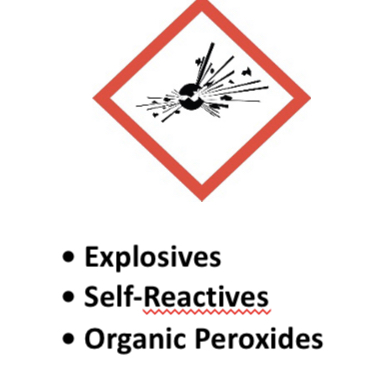
31
New cards
flame
\
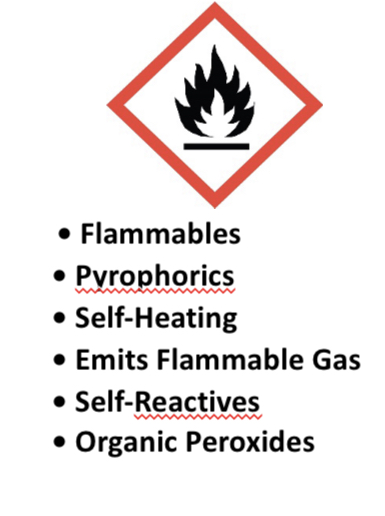
32
New cards
flame over circle
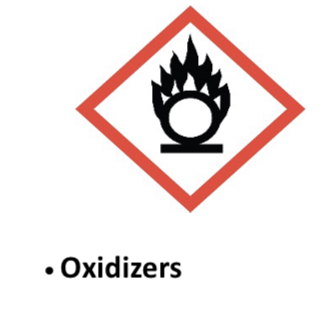
33
New cards
glass cylinder
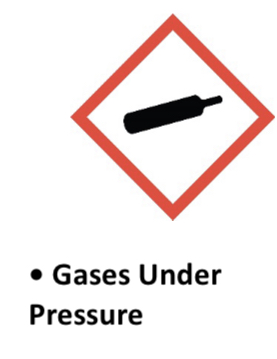
34
New cards
corrosion
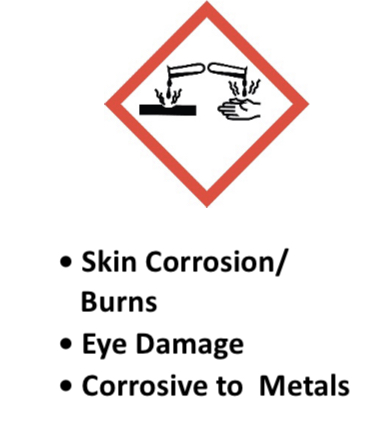
35
New cards
Health Hazard Pictograms
* skull over crossbones
* corrosion
* exclamation mark
* health hazard
* corrosion
* exclamation mark
* health hazard
36
New cards
skull over crossbones
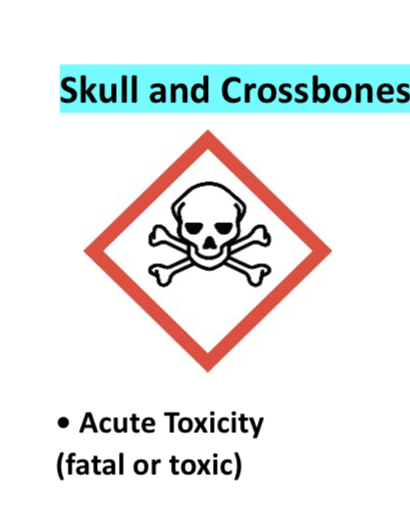
37
New cards
exclamation mark
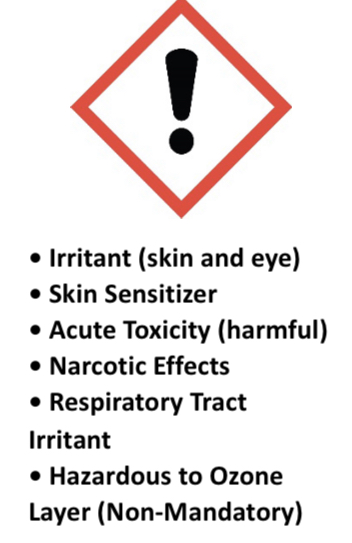
38
New cards
health hazard
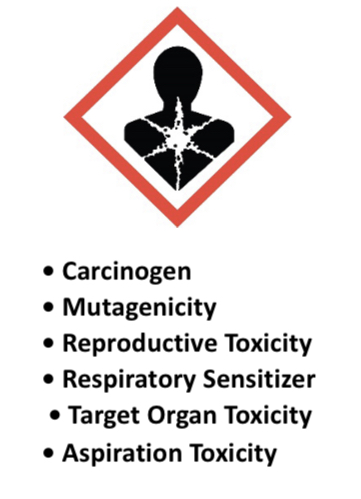
39
New cards
environment - Environmental Hazard Pictogram
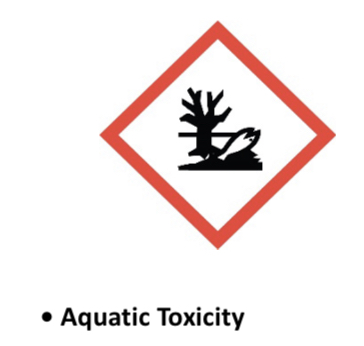
40
New cards
Transport Pictograms

41
New cards
danger =
severe hazards
42
New cards
warning =
less severe harzards
43
New cards
signal words
Used to emphasize hazard and discriminate between levels of hazard
44
New cards
Hazard Statements
A single harmonized hazard statement for each level of hazard within each hazard class
* Example: Flammable liquids
* Category 1: Extremely flammable liquid and vapour
* Category 2: Highly flammable liquid and vapour
* Category 3: Flammable liquid and vapour
* Category 4: Combustible liquid
* Example: Flammable liquids
* Category 1: Extremely flammable liquid and vapour
* Category 2: Highly flammable liquid and vapour
* Category 3: Flammable liquid and vapour
* Category 4: Combustible liquid
45
New cards
Precautionary Statement
A phrase that describes recommended measures to be taken to minimize or prevent adverse effects resulting from exposure to a hazardous chemical, or improper storage or handling of a hazardous chemical
* There are four types of precautionary statements:
* **Prevention** (to minimize exposure)
* **Response** (in case of accidental spillage or exposure emergency response, and first-aid)
* **Storage**
* **Disposal**
\
Statements may be combined to save space or improve readability
* There are four types of precautionary statements:
* **Prevention** (to minimize exposure)
* **Response** (in case of accidental spillage or exposure emergency response, and first-aid)
* **Storage**
* **Disposal**
\
Statements may be combined to save space or improve readability
46
New cards
Creating Secondary Labels
* Employers have the option to create their own workplace labels
* All nonspecific containers must be labeled with the following information:
* Name of Product
* Signal Word (Warning, Danger)
* Hazard Statement
* Appropriate Hazard Pictograms
* All nonspecific containers must be labeled with the following information:
* Name of Product
* Signal Word (Warning, Danger)
* Hazard Statement
* Appropriate Hazard Pictograms
47
New cards
Secondary labels must contain
two key pieces of information: the identity of the hazardous chemical(s) in the container (e.g., chemical name) and the hazards present. There are many ways to communicate this hazard information.
* Employers should select a system that will work for each location.
* Employers should select a system that will work for each location.
48
New cards
When are Secondary Labels Required?
Often, laboratory operations require transferring chemicals from the original labeled container into a secondary container (e.g., beaker, flask, or bottle). Portable containers must comply with the labeling requirements if any of the following events occur:
* The material is not used within the work shift of the individual who makes the transfer
* The worker who made the transfer leaves the work area
* The container is moved to another work area and is no longer in the possession of the worker who filled the container
* Labels on portable containers are not required if the worker who made the transfer uses all of the contents during the work shift
* The material is not used within the work shift of the individual who makes the transfer
* The worker who made the transfer leaves the work area
* The container is moved to another work area and is no longer in the possession of the worker who filled the container
* Labels on portable containers are not required if the worker who made the transfer uses all of the contents during the work shift
49
New cards
What are the differences when labeling secondary containers?
Old Labels used NFPA
* \
* 4=Severe Hazard and 1=Minor Hazard
\
News Labels following GHS
* 1=Severe Hazard and 4=Minor Hazard
* Secondary Containers DO NOT contain numbers
\
Both GHS and NFPA can co-exist, however it may cause some confusion
* \
* 4=Severe Hazard and 1=Minor Hazard
\
News Labels following GHS
* 1=Severe Hazard and 4=Minor Hazard
* Secondary Containers DO NOT contain numbers
\
Both GHS and NFPA can co-exist, however it may cause some confusion
50
New cards
I accidentally spilled my monomer which section can I find to clean it up?
Section 6
51
New cards
Both GHS and NFPA can co-exist, however
it may cause some confusion